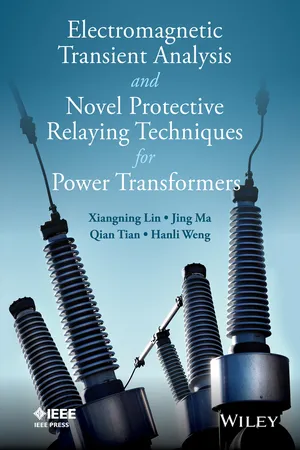
Electromagnetic Transient Analysis and Novel Protective Relaying Techniques for Power Transformers
- English
- ePUB (mobile friendly)
- Available on iOS & Android
Electromagnetic Transient Analysis and Novel Protective Relaying Techniques for Power Transformers
About This Book
An advanced level examination of the latest developments in power transformer protection
This book addresses the technical challenges of transformer malfunction analysis as well as protection. One of the current research directions is the malfunction mechanism analysis due to nonlinearity of transformer core and comprehensive countermeasures on improving the performance of transformer differential protection. Here, the authors summarize their research outcomes and present a set of recent research advances in the electromagnetic transient analysis, the application on power transformer protections, and present a more systematic investigation and review in this field. This research area is still progressing, especially with the fast development of Smart Grid. This book is an important addition to the literature and will enhance significant advancement in research. It is a good reference book for researchers in power transformer protection research and a good text book for graduate and undergraduate students in electrical engineering.
Chapter headings include: Transformer differential protection principle and existing problem analysis; Malfunction mechanism analysis due to nonlinearity of transformer core; Novel analysis tools on operating characteristics of Transformer differential protection; Novel magnetizing inrush identification schemes; Comprehensive countermeasures on improving the performance of transformer differential protection
- An advanced level examination of the latest developments in power transformer protection
- Presents a new and systematic view of power transformer protection, enabling readers to design new models and consider fresher design approaches
- Offers a set of approaches to optimize the power system from a microeconomic point of view
Frequently asked questions
Information
Chapter 1
Principles of Transformer Differential Protection and Existing Problem Analysis
1.1 Introduction
- Matching and error of the current transformer (CT) ratio.
- Transformer tap change.
- Transfer error of the CT increases during the transient process of the external fault current.
- Single-phase earth fault on the transformer's high voltage side via high resistance.
- Inter-turn short circuit with outgoing current.
- The magnetizing inrush.
Table of contents
- Cover
- Title Page
- Copyright
- About the Authors
- Preface
- Chapter 1: Principles of Transformer Differential Protection and Existing Problem Analysis
- Chapter 2: Malfunction Mechanism Analysis due to Nonlinearity of Transformer Core
- Chapter 3: Novel Analysis Tools on Operating Characteristics of Transformer Differential Protection
- Chapter 4: Novel Magnetizing Inrush Identification Schemes
- Chapter 5: Comprehensive Countermeasures for Improving the Performance of Transformer Differential Protection
- Index
- End User License Agreement